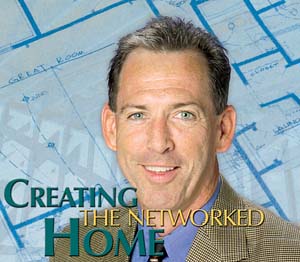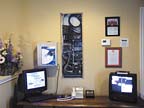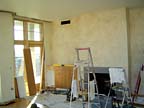

That is the concept behind the electronic smart home, along with control of lighting and heating/cooling. Structured wiring makes it possible for security dealers and systems integrators to offer customers these benefits in the easiest and most efficient way.
“The structured wiring panel is really a metal box with a lid on it – it is a means to an end,†concedes Clint Owens, president of LiveWire Technologies, Portland, Ore., which has a 10,000-square-foot design facility that showcases five home theaters. “Very few customers come in with desires for structured wiring in the wall. Instead, they have a list of capabilities they want.â€
“No one is interested in hearing about bits and bytes and speeds,†admits Richard Genece, director of residential vertical marketing for GE Infrastructure, Security, Arden Hills, Minn. “It’s the applications that are driving this.â€

Mark McDougall, vice president of security systems at Palmetto Security Systems, Hilton Head, S.C., agrees that installing companies should focus on selling the benefits and the appeal of a structured wiring system.
“Instead of selling the homeowner on security, you sell them on home networking, computer connections and sound,†McDougall says, adding that his company is experiencing growth in the southeast part of the United States. “Whether the age group is young or old, they like the technology,†McDougall says. Palmetto Security is a division of an electric utility company, and a First Alert Professional Security Systems dealer.

Photo courtesy of Lomac Information Systems
Prewires and Packages
Palmetto Security prewires new construction with the basics and then encourages customers to install more features. The basic structured wiring package includes three to four computer outlets, five to 10 telephones, and cable television connections for four to eight televisions, McDougall describes.Palmetto Security’s basic security system prewire includes security for three doors, one motion detector and a keypad. Monitored smoke detectors can be added as an upgrade, along with additional keypads or other security devices.
Distributed audio is in each room and then can be upgraded to surround sound in one or two rooms, McDougall explains.
Palmetto Security prewires homes that start at approximately 2,200 square feet, which sell for $140 per square foot to $210 per square foot, McDougall estimates. For lower-end homes valued at $150,000 or less, Palmetto Security installs structured wiring only when the homeowner buys it in advance of construction.
“Most of the time with structured wiring, builders put the basics in and you have to wait until someone purchases the home,†points out Larry Comeaux, director of sales for Acadiana Security Plus, Broussard, La., which also is a First Alert Professional Security Systems dealership. “We don’t prewire until we talk with the customer on a custom home. You can sell more by talking to the customer.â€
He points out that builders share in the increased income from upgrades of basic structured wiring systems. Acadiana makes its margin on prewiring, rather than wiring at cost or a loss while counting on profits to come later from selling additional features to homeowners.
A basic prewire for Acadiana is two drops per room, one a telephone line and the other for television. Prewiring also includes coaxial cable for cable or satellite television service. Telephone wires are run in Cat 5 cable so they can be used for computer networking or data ports.
Adds Genece of GE Infrastructure, Security, “Builders are interested in using structured wiring to sell more homes and improve their operations.â€

Trends in Add-ons
Home video surveillance is becoming a popular add-on to structured wiring, installers say. Not only is it used to check a home’s entrances, but private locations outdoors such as pool and backyard areas. The security industry may find it will need to push the installation of video surveillance products to homeowners to verify alarms in the future.Owens of LiveWire Technologies puts the video signal in a DVR that can be accessed remotely over the Internet rather than on a television channel in the home. He has found the CCTV channel sometimes lowers picture quality on other channels.
In higher-end homes and vacation homes, video surveillance is used to check the exterior of the house, the driveway and even some areas of the interior, says Kevin Yeager, owner of integrator Yeager Services, York, Pa. These systems often use infrared sensors to trigger recording and notify the owner. Sensors also are used to indicate activity on driveways.
“We’re probably on the cusp of getting into a lot of alarm confirmation products,†says Angelo Tuzi, director of Grand Alarms Ltd., Concord, Ontario. Tuzi predicts that “as an industry, we will be forced into alarm confirmation to reduce costs to authorities who respond to these.â€
Cary Pierce, operations manager for Lomac Information Systems, Victorville, Calif., has observed a trend in online gaming, which has affected his business.
“The one thing I see happening a lot is the X-Box stuff and networking, and being able to play online,†he says. “We set up jacks in the wall next to the couch and plug in the controls instead of having wires all over the floor. People love it, and it makes for a nice, neat installation.â€
Pierce also automates garage door openers for remote operation or to confirm that the door was closed.
“What we’re seeing a big demand for now is [multiple] zones of heating and air conditioning,†Yeager says. “They want it all to be handled and controlled from centralized locations. Some of the houses…may have 14 zones of heat.â€
In such homes, which average 4,000 square feet, each room and portions of some rooms may be on a separate zone. “Buying home management isn’t just for the fun of controlling the whole house remotely. If the system is programmed properly, it’s also a real energy savings,†Yeager explains.

Let there be lighting
Energy savings also can come from automated lighting systems, which some installing companies are more successful at selling than others.Lomac Information Systems installs “scenes†for lighting in many of its clients’ homes, especially in the low-desert areas of Palm Springs and Palm Desert, Calif., where the company has a second office. In some of these homes, motion sensors in bathrooms and hallways detect people in the middle of the night and slowly turn lights up to 30 percent of their maximum brightness until residents’ eyes become accustomed to the light.
“In the bedroom, I’ll set up one of my programmable switches next to the bed so the homeowner just reaches over and presses button 1 and it turns off the lights, sets back the thermostat and arms the alarm for the night,†Pierce relates. “In the morning, you press button 2 and it disarms the alarm, brings up house temperature and starts the coffee pot. It’s really a neat system.â€
Automated lighting control may not sell as successfully for installers who target homes valued at less than $1 million, says John Prince, president/CEO of Atlantic Home Technology in Jacksonville, Fla. Still, the popularity of lighting control systems varies by home value and region of the country, Prince adds.
“I haven’t seen lighting control take off in homes of less than $1 million,†he notes.
Prince also hasn’t sold lighting control because of state licensing.
“We’re a low voltage integrator, not an electrical contractor, so in Florida, we can’t touch any wire over 49 volts,†he adds. “If [lighting] worked for us, we’d have to have a good relationship with an electrician.â€
Prince ranks the most popular structured wiring amenities in his area as security, home theater, surround sound, computer networking with high-speed Internet, and distributed audio.

Future Technologies, Benefits
Some home systems integrators believe that newer technologies will make structured wiring more necessary, while others believe it will lessen the need for structured wiring.“Over the next 12 to 24 months, we’re going to see a lot of new technologies,†says Don Hains, owner of Sure-Lock-Homes, Burnsville, Minn. “I think Voice over Internet Protocol (VoIP) is going to become very big, and I believe we need to be putting in more phone jacks that can be converted into network jacks so as those technologies come in, you can switch from a phone jack to a network jack. That’s why we need to do structured wiring to make it easy to do the switch.
“If you don’t have networks in, it won’t be long before video will be coming over networks and you will need to put in a network outlet where the TV outlet is,†Hains predicts. Fiber-optic cable is installed in some neighborhoods he serves where data, phone and video is an IP address.
“When you do that, you have to put a redundant network in the home – one for data and one for video – because the firewall blocks video in that particular neighborhood,†Hains points out.
Avi Rosenthal, national program manager for On-Q Home, Middletown, Pa., sees fiber-optic cable to the house as the future. “Verizon and GTE both announced fiber to the curb,†he reports. “We need something that will interface and distribute as it comes down that fiber line. Our focus in life is to distribute signals around the house. We’re in the distribution business.â€
But what if the distribution of all data, audio and video in a home can be accomplished without wires?
“I see the possibility, with wireless networking going on, of structured wiring not being as important,†suggests Mark Johns, vice president of purchasing for Morrison Homes, Jacksonville, Fla. “But having just a wireless hub in your house is pretty far off. Another possibility is as appliances become more standardized, if someone comes up with a standard for an Internet connection for them.â€
Owens of LiveWire Technologies has started a joint venture company called Techheads to set up personal computers and manage in-house networks. “There seems to be an end of the road or even a dead-end for contractors who put wires in walls,†he observes. “Then another set of contractors finish the devices.
“We believe IP-enabled devices that flow into homes will require a different skill-set of technicians than the guy who wired the house,†Owens predicts.
Some companies have already developed futuristic uses. Honeywell’s FutureSmart structured wiring system offers voice recognition that users can name and access through voice over a telephone or computer connection or through a wireless computer, says Ray Dittrich, vice president sales, Honeywell Security and Custom Electronics, Syosset, N.Y. “The system can get stock quotes in real time from the Internet,†Dittrich says, as one example of this capability.
Yeager thinks there is no limit to future possibilities for structured wiring and home control systems. “Whatever you can come up with, you can do with home management,†he insists.

Photos courtesy of LiveWire Technologies
Sidebar
Customers and Builders Weigh in
Patti Robertson, a full-time homemaker in Jacksonville, Fla., along with her husband, chose a structured wiring system last year for their family’s new home that was installed by Atlantic Home Technology, Jacksonville, Fla.“It gives you a great deal of return for your money,†Robertson maintains. “It continues to pay benefits over a long period of time.â€
She and her husband chose the features of their structured wiring system carefully. “We tried to weigh it out and select things that would serve us over many years and return value when we sold our home,†she explains.
In addition to security on all doors and windows, cable television, high-speed Internet access and telephone jacks throughout the house, they added an intercom system for internal and front-door communication, and a home theater. They also prewired for an additional home theater they plan to add later.
“I felt that it would give us a leg up over other homes that might be comparable to ours and would make our home more attractive, and also justify our price that we might ask in the future,†she asserts. “I think it’s a good investment. If you have a little bit of freedom with your money, it’s well worth looking at.â€
Many developers and builders also are sold on structured wiring.
“Every home we build has structured wiring in it,†says Mark Johns, vice president of purchasing for Morrison Homes, Jacksonville, Fla. “The biggest reason for it is that in a lot of planned developments, the developer has said every house will be wired. It brings value to the homes.â€
Johns maintains structured wiring is becoming as common as home appliances.
“I do believe with some of your higher-end homes it won’t be seen as an option,†says Kevin Yeager, owner of integrator Yeager Services, York, Pa., about structured wiring systems. He estimates the value of the average home he works on to be approximately $1 million.
“Structured cabling systems within the residential market are pretty much a standard offering by today’s homebuilder,†maintains Bryan Watts, channel manager for DSC, Concord, Ontario.
“Surveys and studies have shown 70 percent of new homes are getting some form of structured cabling. From our view, this trend will continue, and we think that eventually it will reach market saturation where a home will not be built without some form of wiring infrastructure in it,†Watts asserts.
“There is certainly much more awareness among the general population of structured cabling in the home,†points out Angelo Tuzi, director of Grand Alarms Ltd., also of Concord, Ontario. “More hardware is being marketed that utilizes that type of network so that also drives demand for it.â€

Photos courtesy of LiveWire Technologies
Sidebar
Learn Structured Wiring at EHX 2005
EHX 2005, the Electronic House Expo, Feb. 22-26 at the Orlando County Convention Center, Orlando, Fla., will feature sessions covering home automation and networking, IP-based media distribution, distributed audio, broadband RF system design, IP telephony, home theater installation and wireless technologies.For more information, telephone (800) 315-1581 or visit www.ehxweb.com.